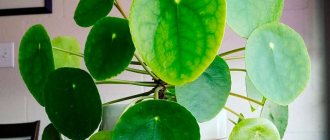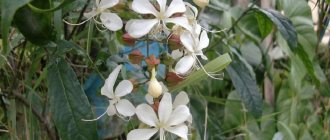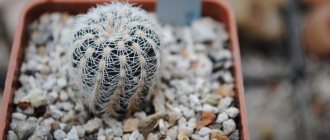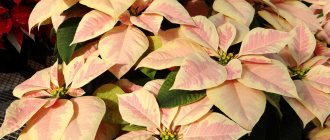Monstera is a large evergreen vine from the Araceae family. Its homeland is the equatorial regions of South and Central America: Panama, Brazil, Mexico, Guatemala, Costa Rica.
The plant has a thick climbing stem with aerial roots. Young leaves on long petioles are whole and leathery to the touch. Then slots and holes of different shapes and sizes appear on them. The color of the leaf blade is dark green, there are varieties with variegated foliage. The inflorescence is a large spadix surrounded by a spathe. Rarely blooms.
In indoor conditions, Monstera grows up to 2-4 meters, and can reach such height in 4-5 years. It produces 2-3 sheets per year. Life expectancy is 10 years or more.
| It produces 2-3 sheets per year. |
| The inflorescence is a large spadix surrounded by a spathe. Rarely blooms. |
| The plant is grown with little difficulty. |
| Perennial. 10 years or more. |
Features of an exotic flower
Monstera belongs to the Araceae family. It is found naturally in South and some areas of Central America, as well as in a number of Asian countries, where it is grown to produce edible fruits. About 50 varieties of the plant are known.
Description of leaves, flowers, fruits
The leaves of the plant are fleshy, large, in nature - up to a meter in diameter. Color varies from light to dark green; There are specimens with marble-colored plates. The first leaves grow small, and characteristic holes appear on them as they grow. Subsequently, the monstera forms large leaves with oblong slits across the entire width. They are first assembled into tubes, which open into a formed plate. Over time, they become pinnately dissected, with noticeable veins and stripes.
When flowering, the plant forms a cylindrical inflorescence, reminiscent of an ear of corn and wrapped in a peculiar white-cream blanket. After some time, the fruit ripens - a berry 20-30 centimeters long, with a thick peel and juicy pulp. The fruit is edible and tastes like pineapple, banana and mango at the same time.
Brief description of cultivation
When grown in an apartment, Monstera quickly grows to the ceiling, while occupying a significant area and width. Therefore, you should give the plant its own corner in the house in advance, without expecting that it will take root on the table or windowsill for a long time.
The flower lives for about 10 years. Needs bright diffused light, regular watering, fertilizing and annual replanting.
Is it possible to keep Monstera at home?
Monstera is one of the popular indoor plants. However, there are a number of superstitions regarding it, some of which are not without foundation.
Why you can: useful properties and signs
The main useful feature of the vine is its ability to absorb electromagnetic radiation that is harmful to humans. Additionally, it ionizes the air and traps dust particles. Therefore, it is very favorable to place the monstera near the refrigerator or microwave oven. However, remember that the plant is poisonous and should not come into contact with dishes and food.
Another amazing property is the elimination of mental clutter. Place a monstera pot near your computer if you happen to take work home. The plant will help create a favorable microclimate that puts you in a businesslike mood, organize your thoughts and increase attentiveness.
Monstera's ability to release moisture allows it to be used as a natural moisturizer.
Signs associated with the positive influence of the flower:
- Removes negative energy from the room. According to legends, monstera feeds on negative energy. It is good to place a pot with a plant in places where there are many visitors every day: in banking institutions, customer service departments, open space offices.
- With good care, it becomes a talisman for the owner and brings good luck.
- Treats headaches and helps cope with stress.
Monstera decorates and enlivens the interior. This property is beneficial for people suffering from depression and mood swings.
Why not
The plant is poisonous, so it should not be planted in a house where there are small children or animals.
Signs associated with the negative influence of the flower:
- Monstera is an energy vampire that draws strength from the inhabitants of the house and their guests.
- Violates the aura. If you and the plant do not get along in character, it will begin to attract troubles to you.
- The flower is considered a “husband’s runner”. An unmarried girl, having him in the house, according to the sign, will not be able to get married. If a woman has problems in her marriage, Monstera will drive her husband to leave the family. And even among friendly spouses, a plant in the bedroom can cause a decrease in sexual attraction.
Most signs are associated with Monstera’s increased need for oxygen. The lack of regular air exchange in the room where the vine grows leads to a deterioration in the well-being of the people living there. Therefore, it is not recommended to place it in the bedroom and nursery.
Humidity
If it is possible to increase air humidity, the plant will thank you with powerful, beautiful foliage.
Moreover, it will actively absorb air moisture through its numerous adventitious roots.
To maintain moisture, the monstera support is wrapped in a thick layer of moss (sphagnum) and placed next to the plant, with “ropes” of roots attached to it.
Moss retains moisture well and releases it gradually. The option with coconut fiber is less successful, since its moisture-holding capacity is lower.
Monstera species
There are several varieties of vines suitable for growing in a city apartment.
Monstera adansonii monstera adansonii
Capable of reaching a height of 8 meters. The leaves are oval-shaped, slightly pointed towards the outer edge, 20 to 55 centimeters long and 15 to 40 centimeters wide, covered with holes. When flowering, the spathe of the cob has a yellowish tint.
Monstera Borsiga monstera borsigiana
It has large dark green leaf blades, evenly cut and shaped like a heart. It is a smaller variety of the delicious monstera.
Monstera pierced or full of holes Monstera pertusa
The owner of leaves heavily mottled with holes, sometimes reaching a size of 1 meter. Flower spadix - up to 10 centimeters in height.
Monstera deliciosa or attractive Monstera deliciosa
The largest species, capable of growing up to 12 meters in the wild. The main distinguishing feature is the presence of an edible fruit that tastes like a cross between a banana and pineapple. At home, it ripens in about 10 months. The heart-shaped leaf blades are pinnately dissected and have holes.
Monstera oblique or unequal-sided Monstera Obliqua
Creeping liana. It got its name due to the uneven growth of the leaves: one half is always slightly larger than the other in size. The leaf plates are elliptical in shape and covered with oval holes. The edges remain intact.
Monstera Karvinskyi Monstera karvinskyi
A plant up to three meters high, with leaves dissected and covered with holes.
Monstera acuminata
The leaf blades are whole, not dissected, and have an elongated shape, slightly pointed towards the outer edge. As they grow, characteristic holes appear on them.
Which indoor flowers are shade-tolerant?
In addition, shade-loving indoor plants are usually unpretentious and easy to care for.
- Aspidistra Aspidistra latifolia / smartgardenguide.com. ...
- Zamioculcas Zamioculcas zamifolia / worldofsucculents.com. ...
- Monstera Monstera is attractive...
- Nephrolepis...
- Sansevieria…
- Fatsia...
- Hedera...
- Chlorophytum
Interesting materials:
Why does my heated towel rail leak? Why are my desktop icons jumping? Why the pseudonym Sievert? Why do birds fly low before it rains? Why do birds fly to the south of the EGE? Why do birds fly south is a mystery? Why do birds return to their native lands? Why doesn't the vacuum cleaner suck up dust? Why should crayfish be cooked alive? Why does sushi rice disintegrate?
How to care for monstera at home
The plant is undemanding to temperature and lighting, which allows it to be grown in different parts of the house. It tolerates temperature changes, dryness and air pollution well, and can withstand lack of watering for some time. At the same time, the vine continues to grow, but stops blooming and bearing fruit.
Where to put it in the apartment
The flower is sensitive to movement. It is better to immediately determine the final place for it and not move it unnecessarily in the future. In deep shade, the monstera can die, and the open sun can leave burns on the leaves.
Illumination
The plant loves bright but diffused lighting with light shading. It is important to create conditions that are optimally close to nature in order to preserve the bright color of the leaves. Lack of light leads to a decrease in the size of the leaf plate and diseases of the aerial roots, which has a detrimental effect on the condition of the entire flower.
Temperature
Monstera feels comfortable in a wide range of temperatures: from 16 to 25 degrees. In cool conditions, its growth slows down, and in warm conditions it becomes more intense. In spring and summer, the optimal temperature is from 20 to 25 degrees, in late autumn and winter - 16–18 degrees. Drafts should be avoided. The room thermometer in a room with Monstera should not fall below 10 degrees.
Watering
The intensity of watering depends on the time of year. In spring and summer, the soil should be moistened abundantly immediately after the top layer has dried. In winter, the frequency of watering is reduced, waiting 1–2 days after the substrate dries.
The flower reacts negatively to both drying out of the soil mixture and stagnation of moisture. Overwatering can cause rot on the roots and spots on the leaf blades.
To water the monstera, soft, settled water is used.
Spraying
The plant really loves the procedure of spraying the leaves with a spray bottle. It is advisable to do this once every 1-2 weeks with well-settled water at room temperature. As monstera leaves become dirty, they should be cleaned of dust using a soft, damp cloth.
Fertilizer
The plant develops well even without additional nutrition. However, feeding will only benefit him. Organic and mineral fertilizers are alternated, using once every 2-3 weeks from the second half of spring until the beginning of autumn.
Trimming
After the active growth of the vine slows down, it is recommended to periodically cut off the top to stimulate the development of side shoots.
Bloom
In nature, Monstera blooms annually, but flowering in an apartment is not easy to achieve. With good care and timely application of fertilizers, a couple of years after planting, Monstera can form an inflorescence of small flowers in the shape of a cob, covered with a white blanket with a cream or yellowish tint. Subsequently, a fruit is formed in place of the cob.
Virulence
The juice of the plant is poisonous: it can cause irritation of the skin and inflammation of the mucous membranes. Unripe fruits are especially dangerous - their consumption can lead to gastric and intestinal bleeding, burns of the oral mucosa.
What to do with aerial roots
Aerial roots do not look very aesthetically pleasing, but are necessary for additional nutrition of the plant. They are usually tied to the trunk and covered with moss on top, which must be moistened with each watering.
Monstera in winter
In winter, it is advisable to give the flower a rest. If possible, the temperature in the room where the monstera grows should be reduced to 16–18 degrees, while avoiding drafts, to which the plant is very sensitive. Watering is reduced to 1-2 times a week (a couple of days after the top layer of soil dries). There is no need to feed the vine in winter.
How to make a flower bloom
Outside of nature, Monstera rarely blooms. To achieve this, create conditions as close as possible to the tropical climate:
- bright but diffused light with slight shading;
- abundant watering and spraying;
- air temperature from 20 to 25 degrees;
- a pot of suitable size in depth and width, correctly selected soil;
- preservation of aerial roots.
If all conditions are met, you can expect the inflorescence to appear 2-3 years after planting.
Fertilizer
Feeding the plant is necessary to ensure intensive growth and spectacular appearance of leaves.
In summer, the plant is fed 2 times a month using liquid complex fertilizers “For ornamental foliage plants.”
It will also respond with rapid growth to watering with mullein solution, which can be used to pamper the beauty twice a season.
With the onset of autumn, they monitor the plant and, in the case of active growing season, continue to feed once a month.
If the wintering temperature decreases, then the frequency of watering the monstera is reduced and the application of fertilizers is eliminated.
Transplanting a plant
Monstera grows quickly and requires regular replanting. The plant is first replanted at an early age, and then annually until the age of 4–5 years. After this period, it is permissible to change the container and soil every 3-4 years.
Soil requirements for monstera
When selecting soil, it is necessary to recreate the soil composition in the tropics as much as possible. The easiest way is to purchase substrate for monstera and palm trees at a flower shop. However, the soil mixture can be prepared at home:
- Combine peat, humus, sand, turf and leaf soil in a ratio of 3:2:1:1:1.
- Turf soil, peat, sand, humus (1:1:1:2).
- Sand, humus, leaf and turf soil (1:1:1:3).
The soil should be light and loose, and the substrate should occupy at least a third of the volume of the pot when planting.
Monstera reproduction
Most often, the plant is propagated vegetatively, using cuttings, but there are methods that involve growing a flower from seeds. It is advisable to carry out all manipulations with monstera with gloves so as not to cause skin irritation.
Reproduction of monstera by apical cuttings
This method is the most popular. The apical shoot is cut from an adult plant and placed in a container with water. The cutting is ready for rooting when at least three root branches appear on it.
Propagation of monstera by stem cuttings
Cuttings containing buds are cut from an old plant. Then the shoots are placed in individual containers with moss, peat or wet sand, and covered with a glass jar on top.
Monstera propagation by leaves
The method is used if it is necessary to root an accidentally broken leaf. To do this, place it in a container with water and wait until the roots appear, and then plant it in prepared soil.
Monstera propagation by layering
A very labor-intensive, but reliable method. Its essence is to force one of the aerial roots to send out its root shoots without separating it from the main plant. To do this, monsteras tie a container of water to the trunk, into which the roots are lowered, or moisten them by spraying, after wrapping them in moss. When the branch has developed sufficiently, it is cut off from the main plant and transplanted into a separate pot.
Reproduction by lateral shoots and rhizome division
When transplanting, you can separate a part of the rhizome with a rosette of leaves or a bud and place it in another container with substrate. The lateral shoots that appear at the bottom of the stem are tried to be rooted in early spring.
Aerial roots
When propagated by this method, the root is separated from the mother plant and placed in water or moistened moss.
Monstera propagation by seeds
This method is rarely used because it is the least effective. To wait for germination, only fresh plant seeds are used. They are placed in a plastic bag filled with damp moss and kept in bright, diffused light at a temperature of 23–25 degrees. The appearance of the first shoots should be expected in about a month and a half. The seed bag must be regularly ventilated and moistened.
How to propagate monstera by stem
For planting, you should select a part of the stem with a bud or leaf. Carefully separating it from the trunk, you need to place it in water and wait for several root shoots to appear. Then the plant can be moved to a container with prepared soil mixture.
Watering
The plant is adapted to life with sufficient moisture. Therefore, infrequent or scanty watering leads to shredding of the leaves, loss of turgor in them, and the appearance of yellow-brown marginal spots.
How to water a monstera: water it abundantly only when the top layer has dried by 5-7 cm, allowing the roots to breathe. Watering frequently, but in small quantities, is not recommended, because it is easy to “flood” the plant.
In this case, the vine droops, dark brown spots appear on the leaves, and fungal infection of the stem may begin.
When humidity is low, which is typical for our apartments, you need to frequently spray the aerial roots of the plant, or direct them into vessels with water.
Possible problems
If the conditions necessary for plant development are not met, problems may arise, including stunted growth, wilting and darkening of leaves.
Why do monstera leaves turn yellow, dry out and fall off?
Lack of nutrients or stagnant soil moisture can cause leaves to turn yellow. If there is a process of premature wilting, most likely it is due to a lack of light or infection with parasites. Leaves can dry out both due to the fault of pests and due to the heat in the room.
Why do monstera leaves turn black?
The leaf blades begin to turn black when overwatered, which results in stagnation of water in the pot. The roots, and then the entire plant, are affected by rot. To stop the process, urgent replacement of the soil, disinfection of the container and pruning of damaged roots will be required. After transplantation, the flower must be watered with a solution of phytosporin. They also treat damaged leaf plates.
Why isn't it growing?
Plant growth stops at temperatures below 19 degrees or lack of light. In addition, the flower may not have enough nutrients for growth due to poor soil or pest damage.
Diseases and pests
Plant diseases are most often associated with errors in care: violation of temperature conditions, lack or excess of moisture, insufficient lighting.
- When overwatered, the leaves turn yellow, and rot may appear on the aerial roots. If the leaf blades dry out, the soil needs to be moistened more often.
- Lack of light causes leaves to fail to reach their normal size. They grow weak and small.
Pests dangerous to flowers:
- Spider mite. It can be identified by the characteristic cobweb network on the leaves of the plant. At the same time, the flower becomes weak and loses its strength. A soap solution applied to the leaves will help deal with mites.
- Mealybug. Monstera becomes lethargic, young leaves and shoots wither, and a white coating appears on them. They fight the bug with a soap sponge, which is used to treat the leaf plates.
- Shield. The leaves begin to quickly fade, and characteristic brown growths appear on the flower. Treatment is similar to that used to kill mealybugs.
- Thrips. Pests appear on the reverse side of the leaf. Outside, you can see a large number of light dots. To combat thrips, the plant is sprayed with an insecticide.
If favorable conditions are created, the monstera will feel comfortable in an apartment. The plant is unpretentious and grows in a wide range of temperatures. Most signs associated with the negative influence of a flower on a person are superstitions that have no basis in reality.
Lighting
Contrary to popular belief, this vine does not at all like dark corners of rooms, where it is often placed. She is comfortable being in a bright room near a window.
On the other hand, you should avoid placing the plant in full sun because the leaves may get burned.
In low light conditions, the leaf of the plant becomes smaller, becomes solid, without jaggedness or holes, and the plant stops growing new shoots. It is worth noting that proper illumination with fluorescent or LED lamps allows you to grow a vine even in the complete absence of sunlight.
The source of artificial lighting is placed no further than 40-60 cm from the leaves of the monstera , choosing lamps designed specifically for growing plants. The light interval is set within a 12-hour day, allowing the plant to breathe at night and approaching the natural rhythm of life.











